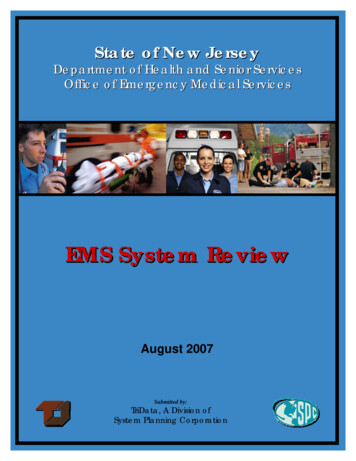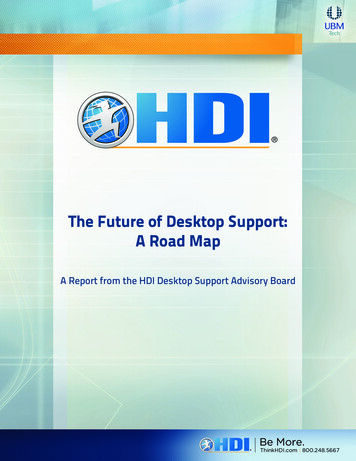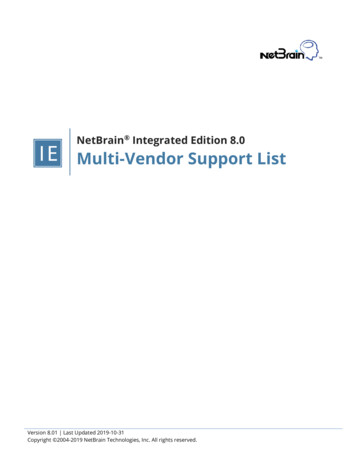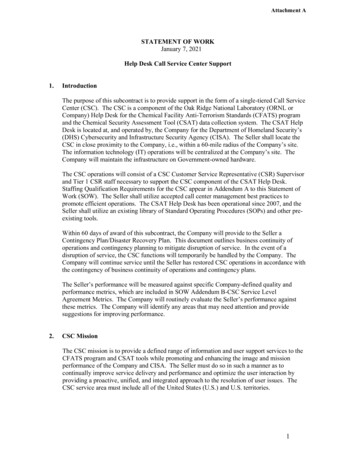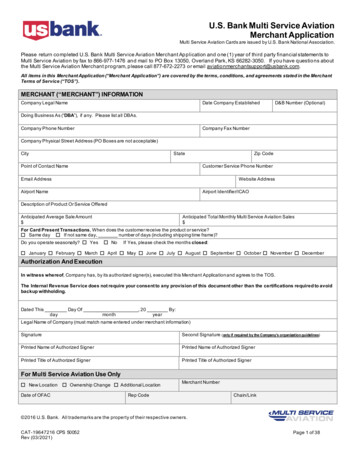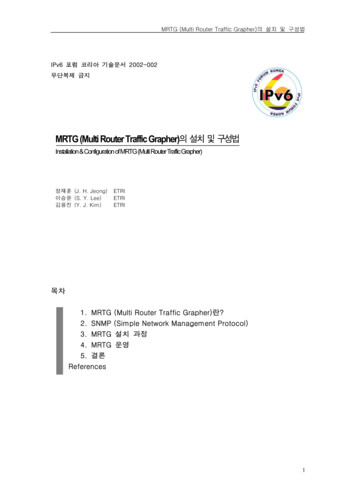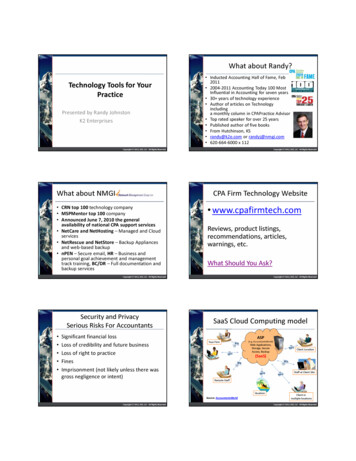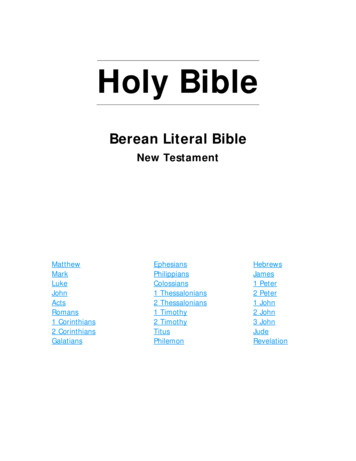
Transcription
M U LT I - T I E R E DS Y S T E MO FS U P P O R TA Blueprint for Massachusetts Educators
This document was developed in collaboration withNovak Education Consulting and Rodriguez EducationalConsulting Agency (RECA); with additional contributionsfrom the University of Connecticut and the HILL for Literacy.Special thanks to the multitude of district, school, andstate stakeholders who provided input in the design of thisreenvisioned MTSS Blueprint.EDUCATIONALCONSULTINGMULTI-TIERED SYSTEM OF SUPPORT BLUEPRINT FOR MA
Why MTSS?All students are capable of success. WhileMassachusetts leads the nation in performance onmultiple measures, we still have students who arenot experiencing the success they deserve.Recent reports such as the “Review ofSpecial Education in the Commonwealth ofMassachusetts: A Synthesis Report” by Hehirand Associates (2014) and “No. 1 for Some:Opportunity and Achievement in Massachusetts”by the Massachusetts Education Equity Partnership(2018) demonstrate the consequences of aninequitable education system for students withdisabilities, students who are English learners,economically disadvantaged students, andstudents of color in Massachusetts.This is not because these students can’t or don’twant to learn. We must recognize that many of ourschools are not organized to meet the needs of alllearners (Meyer, Rose & Gordon, 2014).Although some students face barriers that havethe potential to interfere with their ability to makeoptimal progress, there is evidence that schoolsand classrooms can raise student achievementdespite these barriers (Hattie, 2018; Meyer, Rose,and Gordon, 2014).For example, through efforts such as wrap-aroundservices, the use of high-quality core curricularmaterials, evidence-based interventions, traumainformed practices, and strategies to engageall learners, schools have the ability to addressfactors that may impact student learning. Schoolscan minimize or eliminate barriers and improvestudent outcomes when they design equitable,tiered, universally-designed systems of supportthat address students’ academic, behavior, andsocial emotional well-being in ways that areculturally sustaining.MTSS is a framework designed to meet the needsof all students by ensuring that schools optimizedata-driven decision making, progress monitoring,and evidence-based supports and strategies withincreasing intensity to sustain student growth.MTSS is not just about tiered interventions, butrather how all the systems in a school or district fittogether to ensure a high quality education for allstudents.To realize this success, multi-tiered systems mustbe supported by leadership, competency, andimplementation drivers to ensure that districtresources and efforts are focused on supportingall students, who can and will learn and succeedwith our support.MULTI-TIERED SYSTEM OF SUPPORT BLUEPRINT FOR MA2
SECTION 1MULTI-TIERED SYSTEM OFSUPPORT (MTSS)What is MTSS?According the Every Student Succeeds Act(ESSA, 2015), a multi-tiered system of support is“a comprehensive continuum of evidence-based,systemic practices to support a rapid response tostudents’ needs, with regular observation to facilitatedata-based instructional decision making.’’Harlacher et al. (2014) described six key tenets of theMTSS framework: All students are capable of grade-level learningwith adequate support. MTSS is rooted in proactivity and prevention. The system utilizes evidence-based practices. Decisions and procedures are driven by schooland student data. The degree of support given to students is basedon their needs. Implementation occurs school-wide and requiresstakeholder collaboration.The current MTSS model in Massachusetts has beenrefined from previous versions. For example, thisblueprint more explicitly focuses on equitable accessand universal design for learning (UDL) and fullyintegrates social emotional and behavioral supportswith academic supports (Lane, Oakes, Cantwell, &Royer, 2016).What is the differencebetween MTSS and RtI?Response to intervention (RtI)was added to the Individualswith Disabilities EducationAct in 2004 as an alternativeevaluation procedure.The goal of RtI was to providescreening for all students, deliveracademic interventions, monitorstudent progress, and use thestudents’ responses to thoseinterventions as a basis fordetermining special educationeligibility (Turse & Albrecht, 2015).ESSA distinctly references multitiered systems of support, but thereis no reference to Response toIntervention (RtI), and in fact theyare two distinct tiered approaches.While RtI focuses on direct services,supports, and interventionsfor students at risk, MTSS isa systematic approach thataddresses conditions for creatingsuccessful and sustainablesystem change while alsosupporting students and staff.As opposed to a reactivemodel that responds to studentachievement declines as arationale for resources andservices, MTSS puts the onuson the system, not the student,and is proactive in getting allstudents what they need.MULTI-TIERED SYSTEM OF SUPPORT BLUEPRINT FOR MA3
B LUEPRI NTCOMPONENTSFoundational Framework and FocusThis blueprint will unpack the components of amulti-tiered system of support (MTSS) through thefoundational framework of universal design forlearning (UDL) and a focus on equitable access.Tiered SupportFoundationalFramework& FocusMTSS provides a continuum of supports, whichare typically conceptualized across three levels ofincreasing intensity (Rodriguez, Loman & Borgmeier,2016).These tiers represent the level of support a studentmay need at any point in his/her/their schooling. Alltiers are universally designed using the principles ofUDL and ensure equitable access for all students. Academic Behavioral Social EmotionalTiered SupportSystem DriversThis section will review the conditions and systemsnecessary to support a robust and effective MTSSapproach, inclusive of the following drivers. Leadership Drivers Competency Drivers Implementation DriversSystemDriversMULTI-TIERED SYSTEM OF SUPPORT BLUEPRINT FOR MA4
CompetencyDriversDESIGN FOR LLEASARNREIIVAcademicTIER 3IntensiveSupport5GNUNMTSS VISUALBehavioralLeadershipDriversTIER 2Targeted SupportTIER 1Universal SupportSocial EmotionalEQUIT ABLE AC CESSImplementationDriversMULTI-TIEREDSYSTEM OF SUPPORTMULTI-TIERED SYSTEM OF SUPPORT BLUEPRINT FOR MA
SECTION 2FOUNDATIONAL FRAMEWORK & FOCUSUDL (Universal Design for Learning)UDLFRAMEWORKCOMPONENTSUniversal design for learning (UDL) is a framework that reduces barriers in instruction,proactively provides appropriate accommodations and supports, and allows for highachievement expectations for all students, regardless of their unique strengths andchallenges. This is done by providing options and choices for students to personalizetheir learning. UDL is an educational framework based on research in cognitiveneuroscience that guides the development of flexible learning environments that canaccommodate learner variability.Multiple Means ofMultiple Means ofMultiple Means ofEngagementRepresentationAction & ExpressionThe Why of LearningThe What of LearningThe How of LearningThe UDL framework, first defined by David Rose, Ed.D. of the Harvard Graduate Schoolof Education and the Center for Applied Special Technology (CAST) in the 1990’s, calls forcreating curriculum from the outset that provides: Multiple means of engagement to tap into learners’ interests, challenge themappropriately, and motivate them to learn, Multiple means of representation to give learners various ways of acquiringinformation and knowledge, and, Multiple means of expression to provide learners with options for demonstratingknowledge and skills.Instructional planning, as defined in the UDL literature, has four parts: goals, methods,materials, and assessments (Meyer, Rose & Gordon, 2014). UDL is intended to increaseaccess and engagement in learning by reducing physical, cognitive, intellectual, andorganizational barriers, as well as other obstacles. Instructional goals, through the UDLlens, focus on standards-based instruction and the design of instruction that allows allstudents to have equitable access to grade-level standards in learning experiences thatare engaging and personalized to their needs. UDL principles also lend themselves toimplementing inclusionary practices in the classroom, including behavioral and socialemotional teaching and learning.MULTI-TIERED SYSTEM OF SUPPORT BLUEPRINT FOR MA6
Equitable AccessAll students receive challenging, grade-appropriate tier I instruction and have equitableaccess to high quality, universally designed academic, behavioral, and social emotionalcurriculum and instruction that integrates culturally sustaining pedagogy and islinguistically responsive. In our planning, it is important to ensure equitable access tohighly qualified teachers along with comprehensive efforts to diversify our workforce.Piper et al. (2006) define access as the ability to obtain a seat in a classroom or toreceive services, whereas equity is the ability to obtain that seat or service regardlessof “ethnicity, language spoken at home, gender, rural or urban location, or regionaldifferences” (p. 2). All students, regardless of disability, English language proficiencystatus, income, race, or academic performance can receive tier 1, 2, and 3 services.Culturally sustaining pedagogy “describes teaching and learning that seeks toperpetuate and foster linguistic, literary, and cultural pluralism as part of the democraticproject of schooling and as a needed response to demographic and social change”(Paris, 2017, p.2). To provide equitable access to tier 1, districts need to ensure that allteachers have access to high-quality curricular materials that support them in craftinglearning experiences that are inclusive and socially just for all students. To do this, schoolsystems have to implement asset and strength-based approaches to teaching andlearning.For example, we must ask ourselves how we can support the dynamic mix of abilities,races, ethnicities, classes, genders, neighborhoods/regions, religions, and interests of ourstudents, staff, families, and communities. When planning instruction, we must considercritical questions like, “Do our schools represent the students and families as theybelieve themselves to be?,” “What interests and engages our students, staff, families, andcommunity?,” and “How do we leverage the skills, capacities, and strengths within ourcommunity as we design learning experiences that meet the needs of all students?”To ensure equitable access, districts must recognize all students as general educationstudents first, and recognize diversity and inclusion as a necessary good. As a result,the focus of MTSS should be creating strong tier 1 systems and supports that aresupplemented, not replaced, by tier 2 and tier 3 supports.MULTI-TIERED SYSTEM OF SUPPORT BLUEPRINT FOR MA7
SECTION 3TIERED SUPPORTThe problem-solving process in MTSS is an ongoing methodology for effective decisionmaking at all levels of the system and across all three tiers (Council of the Great CitySchools, 2012). The tiers in this model represent instruction and supports.Within the MTSS model, universal supports suchas high quality, universally designed, culturallysustaining, and evidence-based curriculum,instruction, and assessments are provided for allstudents.Movement amongst the three tiers is fluidand is not determined or defined by specificdesignations, such as diagnosed disabilities.Rather, movement is supported by data fromuniversal screeners, diagnostic assessments,progress monitoring, and how a student respondsto one level of intervention.TIER 3IntensiveSupportTIER 2Targeted SupportTIER 1Universal SupportAny and all students should have access tosupports when they need them. In addition,obtaining services at one point does not mean that students will always need that levelof support. The MTSS process is not always linear, but rather oriented around problemsolving.When data suggests that students require more or less intensive supports to aid eitherremediation or enrichment, they will move throughout the tiers based on that need.No student should be labeled by an intervention tier. For example, a child is not a “tier 2student” but rather a student requiring tier 2 supports in a specific skill/content area(s).In addition, when a student receives interventions in tier 2, it should not replace tier 1supports. These supports build upon one another. Moreover, students can move fluidlythrough tier 1, 2, and 3 supports as needed. For example, if data suggests that students arenot meeting the standards, what additional supports may they need? Similarly, if studentssignificantly exceed the standards, what tier 2 supports may be necessary to optimizechallenge and promote growth? It’s also important to note that students may need tier 2supports in one area (e.g., math standards) but may need only tier 1 supports in anotherarea (e.g., relationship-building).MULTI-TIERED SYSTEM OF SUPPORT BLUEPRINT FOR MA8
Tier 1TIER 3IntensiveSupportTIER 2Targeted SupportTIER 1Universal SupportTIER 3IntensiveSupportTIER 2Targeted SupportThese are supports available to all students through a generaleducation program. Inclusive practice, which is linguisticallyresponsive and culturally sustaining, is a cornerstone of tier 1.Inclusive practice is defined as “instructional and behavioralstrategies that improve academic and social emotionaloutcomes for all students, with and without disabilities, in generaleducation settings” (Educator Effectiveness Guidebook forInclusive Practice, 2017). For example, providing students witha high-quality, coherent curriculum that provides options andchoices for how they learn (i.e, access to books, videos, or directteacher instruction), what materials, scaffolds and supports theyneed to learn (i.e., visuals, exemplars, graphic organizers, rubrics,etc.), and how they can express what they have learned
MULTI-TIERED SYSTEM OF SUPPORT BLUEPRINT FOR MA. SECTION 3. TIERED SUPPORT. The problem-solving process in MTSS is an ongoing methodology for effective decision making at all levels of the system and across all three tiers (Council of the Great City . Schools, 2012). The tiers in this model represent instruction and supports. Within the MTSS model, universal supports such . as high quality .
